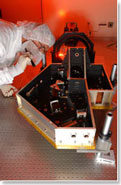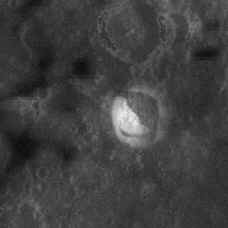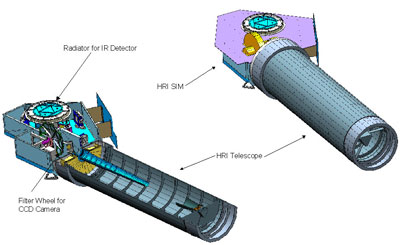
The first of its kind, Deep Impact's High Resolution Instrument (HRI) is one of the largest instruments built to date for an interplanetary mission. Here, a Ball Aerospace test engineer studies the alignment of the SIM optics before the SIM is attached to the HRI. |
The High Resolution Instrument (HRI), designed and built by Ball Aerospace & Technologies Corp., is the main scientific instrument on the flyby spacecraft. Comprised of a telescope with a 30 cm (11.8 inch) aperture, an infrared (IR) spectrometer, and a multi-spectral CCD camera, the HRI CCD camera will image the comet with less than 2 m (6 feet) per pixel scale when the flyby spacecraft is 700 km (420 miles) away. That is similar to resolving a car from across the state of Colorado. At this scale the crater that forms would be about 60 to 100 pixels across, looking something like the simulated image below.

Simulation of HRI crater image 700 km from the surface. |
The IR spectrometer will take images with a per pixel scale of 10 m (33 feet) at closest approach. The HRI's science camera will provide five times higher resolution images than the Medium Resolution Instrument, making it ideal for viewing the comet's nucleus. It is the only one of the three instruments to feature a special imaging module called the Spectral Imaging Module (SIM), which allows it to view in color, white light, and infrared.

Ball Aerospace's test engineers study the alignment of the optics on the SIM bench but the HRI, on which the SIM gets mounted, is not in the picture. |
The HRI is one of the largest instruments built to date for planetary science and the first of its kind, although it employs technologies from the Wide Field Camera 3, the next-generation imaging instrument that Ball Aerospace & Technologies Corp. developed for the Hubble Space Telescope.
| High-Resolution Instrument (HRI) | Medium-Resolution Instrument (MRI) | Impactor Targeting Sensor (ITS) |












